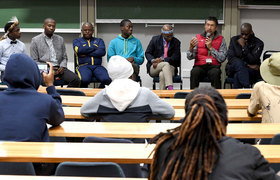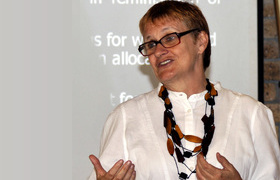Men are dying younger worldwide
15 August 2025 | Story Ridovhona Mbulaheni. Photo Raymond Botha. Read time 5 min.
Men across the world are dying younger and experiencing higher rates of illness than women, and it’s time for governments, global health agencies and funders to act decisively.
That’s the message from a new Bulletin of the World Health Organization article authored by Dr Morna Cornell, an honorary research associate at the University of Cape Town’s (UCT) Centre for Integrated Data and Epidemiological Research (CIDER). She warns that men’s health has been systematically neglected for decades.
The data is stark: in 2023, global life expectancy was 71 years for men compared to 76 for women – a five-year gap that has remained unchanged since 1950. Mortality rates tell an even more sobering story, with 176 deaths per 1 000 men compared to 113 per 1 000 women. These disparities are even greater among men marginalised by race, disability, age or sexual orientation, particularly in post-colonial societies.
“In southern Africa, the migrant labour system left a devastating legacy for men’s health. Young men lived and worked in harsh, unsafe conditions and carried diseases such as HIV and tuberculosis back to rural communities. This structural harm is still felt today,” said Dr Cornell.
“Men and women are too often treated as competing populations, but when we look at the data, men are clearly among the furthest behind.”
Despite this evidence, men’s health remains largely absent from the priorities of international health agencies, funding bodies and national programmes. Men are rarely identified as a vulnerable group in health policies, and discussions about men’s health are often politically charged, viewed as reinforcing male privilege rather than addressing legitimate health inequities.
“Men and women are too often treated as competing populations, but when we look at the data, men are clearly among the furthest behind,” Cornell noted. “Ignoring men’s health undermines progress towards the Sustainable Development Goals’ (SDGs) pledge to leave no one behind.”
Innovative entry points
Over the past 15 years, a handful of countries – including Australia, Brazil, Ireland, Malaysia, Mongolia, South Africa and Iran – have developed national men’s health policies, some decades after implementing women’s health strategies. These policies acknowledge men’s higher mortality and lower engagement with health services, and they propose innovative entry points:
- South Africa: using voluntary medical male circumcision as a gateway to broader health services
- Brazil: engaging men through fatherhood initiatives
- Canada: promoting positive aspects of masculinity to encourage care-seeking behaviour
- Australia and Ireland: focusing on marginalised men most at risk.
“Reducing violence requires more than health policy. It demands coordinated action against the alcohol and firearm industries, and strong global alliances to protect vulnerable young men.”
In Leeds, United Kingdom (UK), all new services must now consider gender in their design, changing how cancer prevention and suicide risk programmes are delivered. Mongolia has integrated men’s health into broader development planning, while Iran tailors policies to local risk factors.
However, Cornell cautions that most policies lack robust monitoring, measurable targets and timelines. To date, only Ireland has formally evaluated its men’s health policy, revealing strong community-level impact but limited success in tackling deep-rooted structural risks.
Coordinated action needed
One of the greatest threats to men’s health is violence, often fuelled by alcohol and firearms. In 2017, South Africa recorded a homicide rate seven times the global average, with 87% of victims being men, most aged 15–44. Alcohol was linked to many of these deaths, and one in three involved firearms.
“Reducing violence requires more than health policy. It demands coordinated action against the alcohol and firearm industries, and strong global alliances to protect vulnerable young men,” Cornell stressed.
The paper also highlights the limited inclusion of men in global health frameworks. A review of 37 regional and global policy documents on sexual and reproductive health found that only five included specific targets for men. When men are mentioned, it is often in relation to women’s health – for example, as partners in preventing mother-to-child transmission of HIV – rather than as individuals with their own health needs.
Cornell calls for global goals to be reframed so that gender is understood to include both men and women, and for the SDGs to be consistently evidence-based and equity-focused.
Developments
There are encouraging developments:
- Over 40 countries now offer human papillomavirus (HPV) vaccination to both boys and girls.
- The UK’s national suicide prevention strategy targets men specifically.
- The European Commission recommends prostate cancer screening across EU member states.
- A growing number of men’s health organisations and dedicated research journals are shaping the evidence base.
Robustly evaluated projects, such as those documented in the Global Action on Men’s Health report Delivering Men’s Health, show that gender-targeted approaches can be highly effective.
Cornell’s message is clear: men’s health must be treated as a core priority in the global push for universal health coverage. Policies must be backed by monitoring frameworks, funding and political commitment, and they must address the social determinants of health – from poverty and unemployment to unsafe housing and discrimination.
“Whether in South Africa, the UK, or anywhere else, inequalities in men’s health are often driven by the same underlying factors: poor working conditions, financial insecurity, violence and social exclusion,” Cornell said. “If we are serious about health equity, we must take men’s health seriously – not as an afterthought, but as an urgent priority.”
 This work is licensed under a Creative Commons Attribution-NoDerivatives 4.0 International License.
This work is licensed under a Creative Commons Attribution-NoDerivatives 4.0 International License.
Please view the republishing articles page for more information.










